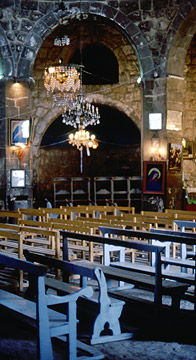Image Resource Bank
Image Gallery |  12 of 15
12 of 15 
Interior of Izra’ Church
This little church in Izra‘, Syria, about 50 miles south of Damascus, has been active since at least the fifth century CE. It already shows the form characteristic of many Christian houses of worship in the Near East and elsewhere, with a small dome over the central space, arched apses, rows of seats, and a pulpit or lectern from which the priest or others can deliver readings or a sermon. Icons (see image 10) form a prominent part of the décor. This church’s presence in this area reflects the steady spread of Christianity from its origins in the “Holy Land” (geographical Palestine, modern state of Israel), among both Greek-speaking and Aramaic-speaking populations in other parts of the Near East during the early centuries. The Greek-speaking communities tended to be Eastern Orthodox in rite and affiliated with the patriarchate of Constantinople (see image 13), but by the 6th century many speakers of Aramaic, Armenian, and Coptic had come to embrace doctrines deemed “heretical” by the Orthodox at the Fourth Ecumenical Council, held at Chalcedon in 451 CE.
Name: View of Izra’ Church
Material: Stone, metal dome
Size: Unknown
Date: 4th or 5th century CE
Place of Origin: Izra‘, Syria
Location: Izra‘, Syria
Registration # and Source: Photograph by Fred M. Donner, August, 1993 CE.
Material: Digital photograph from 35mm slide
Size: 1.226 x .86 inches (4800 dpi)
Date: 1993

 Fred M. Donner
Fred M. Donner
Professor of Near Eastern History, University of Chicago




